2008 MERCEDES-BENZ A-CLASS HATCHBACK towing
[x] Cancel search: towingPage 160 of 305
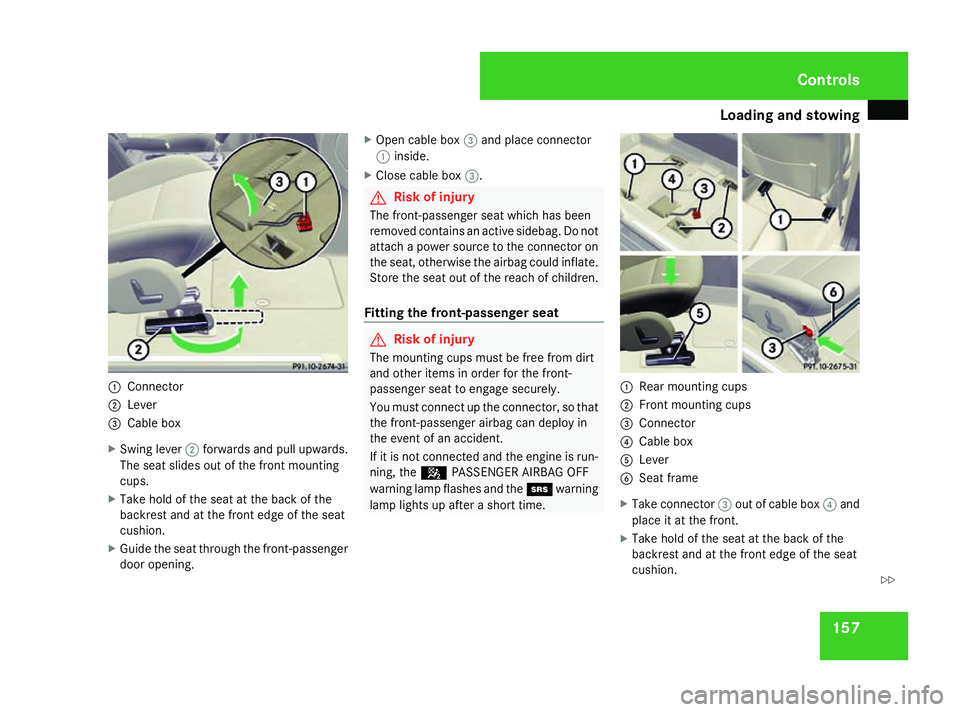
Loading and stowing
1571
Connector
2 Lever
3 Cable box
X Swing lever 2forwards and pull upwards.
The seat slides out of the front mounting
cups.
X Take hold of the seat at the back of the
backrest and at the front edge of the seat
cushion.
X Guide the seat through the front-passenger
door opening. X
Open cable box 3and place connector
1 inside.
X Close cable box 3. G
Risk of injury
The front-passenger seat which has been
removed contains an active sidebag. Do not
attach a power source to the connector on
the seat, otherwise the airbag could inflate.
Store the seat out of the reach of children.
Fitting the front-passenger seat G
Risk of injury
The mounting cups must be free from dirt
and other items in order for the front-
passenger seat to engage securely.
You must connect up the connector, so that
the front-passenger airbag can deploy in
the event of an accident.
If it is not connected and the engine is run-
ning, the 5PASSENGER AIRBAG OFF
warning lamp flashes and the 1warning
lamp lights up after a short time. 1
Rear mounting cups
2 Front mounting cups
3 Connector
4 Cable box
5 Lever
6 Seat frame
X Take connector 3out of cable box 4and
place it at the front.
X Take hold of the seat at the back of the
backrest and at the front edge of the seat
cushion. Controls
169_AKB; 2; 4, en-GB
wdomann,
Version: 2.10.6
2008-07-16T08:52:06+02:00 - Seite 157 ZDateiname: 6515_0315_02_buchblock.pdf; preflight
Page 161 of 305

Loading and stowing
158
X
Guide the seat through the front-passenger
door opening.
X Move the seat into position over the mount-
ing cups.
X Insert the seat hook into rear mounting
cups 1.
X Push the front of the seat down until it
engages.
Lever 5springs back to its starting posi-
tion. Only then is the seat correctly locked
in position.
X Route connector 3over seat frame 6.
X Insert connector 3into the coupling on
the seat. G
Risk of injury
Before starting off, make sure that the seat
has engaged properly. Folding backrest on the front-
passenger seat*
Folding the front-passenger seat back-
rest forward 1
Release handle
X Push the backrest back slightly.
X Pull the release handle 1and swing the
backrest fully onto the seat cushion until it
engages. Folding back the front-passenger seat
backrest X
Push the backrest down slightly and pull
release handle 1.
X Swing the backrest back until it engages. Bag hook
There is a bag hook in the luggage compart-
ment on the left-hand side.
! The bag hook can bear a maximum load
of 5 kg. Do not use it to secure a load. 1
Bag hook
X To open: press bag hook 1(arrow).
Bag hook 1slides out. Controls
* optional
169_AKB; 2; 4, en-GB
wdomann,
Version: 2.10.6
2008-07-16T08:52:06+02:00 - Seite 158 Dateiname: 6515_0315_02_buchblock.pdf; preflight
Page 162 of 305
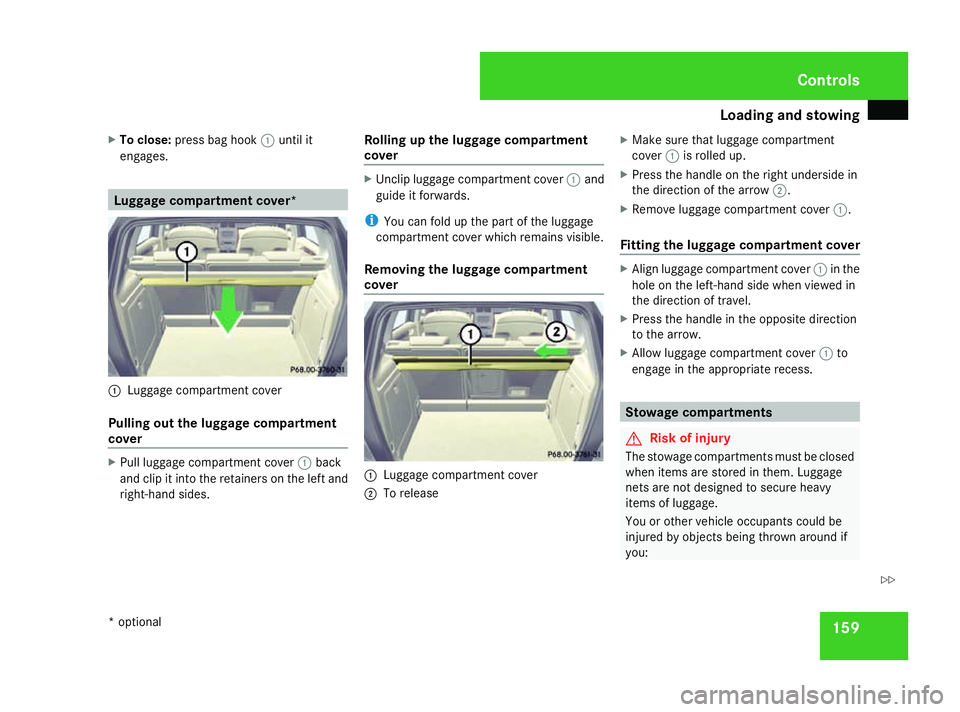
Loading and stowing
159
X
To close: press bag hook 1until it
engages. Luggage compartment cover*
1
Luggage compartment cover
Pulling out the luggage compartment
cover X
Pull luggage compartment cover 1back
and clip it into the retainers on the left and
right-hand sides. Rolling up the luggage compartment
cover X
Unclip luggage compartment cover 1and
guide it forwards.
i You can fold up the part of the luggage
compartment cover which remains visible.
Removing the luggage compartment
cover 1
Luggage compartment cover
2 To release X
Make sure that luggage compartment
cover 1is rolled up.
X Press the handle on the right underside in
the direction of the arrow 2.
X Remove luggage compartment cover 1.
Fitting the luggage compartment cover X
Align luggage compartment cover 1in the
hole on the left-hand side when viewed in
the direction of travel.
X Press the handle in the opposite direction
to the arrow.
X Allow luggage compartment cover 1to
engage in the appropriate recess. Stowage compartments
G
Risk of injury
The stowage compartments must be closed
when items are stored in them. Luggage
nets are not designed to secure heavy
items of luggage.
You or other vehicle occupants could be
injured by objects being thrown around if
you: Controls
* optional
169_AKB; 2; 4, en-GB
wdomann
, Version: 2.10.6 2008-07-16T08:52:06+02:00 - Seite 159 ZDateiname: 6515_0315_02_buchblock.pdf; preflight
Page 163 of 305
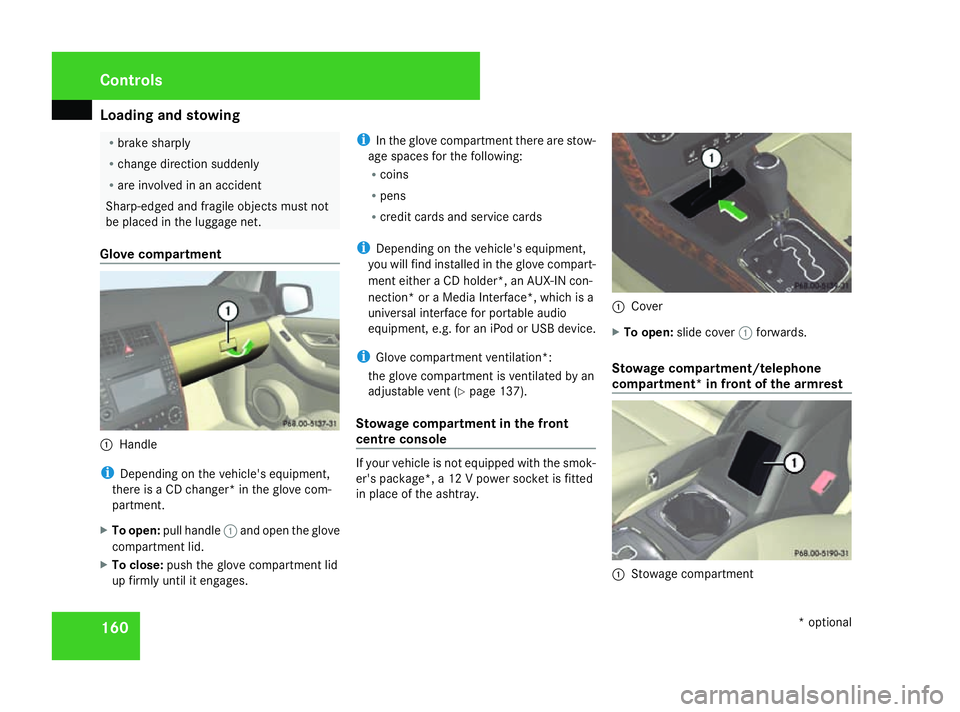
Loading and stowing
160 R
brake sharply
R change direction suddenly
R are involved in an accident
Sharp-edged and fragile objects must not
be placed in the luggage net.
Glove compartment 1
Handle
i Depending on the vehicle's equipment,
there is a CD changer* in the glove com-
partment.
X To open: pull handle 1and open the glove
compartment lid.
X To close: push the glove compartment lid
up firmly until it engages. i
In the glove compartment there are stow-
age spaces for the following:
R coins
R pens
R credit cards and service cards
i Depending on the vehicle's equipment,
you will find installed in the glove compart-
ment either a CD holder*, an AUX-IN con-
nection* or a Media Interface*, which is a
universal interface for portable audio
equipment, e.g. for an iPod or USB device.
i Glove compartment ventilation*:
the glove compartment is ventilated by an
adjustable vent (Y page 137).
Stowage compartment in the front
centre console If your vehicle is not equipped with the smok-
er's package*, a 12 V power socket is fitted
in place of the ashtray. 1
Cover
X To open: slide cover 1forwards.
Stowage compartment/telephone
compartment* in front of the armrest 1
Stowage compartment Controls
* optional
169_AKB; 2; 4, en-GB
wdomann,
Version: 2.10.6 2008-07-16T08:52:06+02:00 - Seite 160Dateiname: 6515_0315_02_buchblock.pdf; preflight
Page 164 of 305
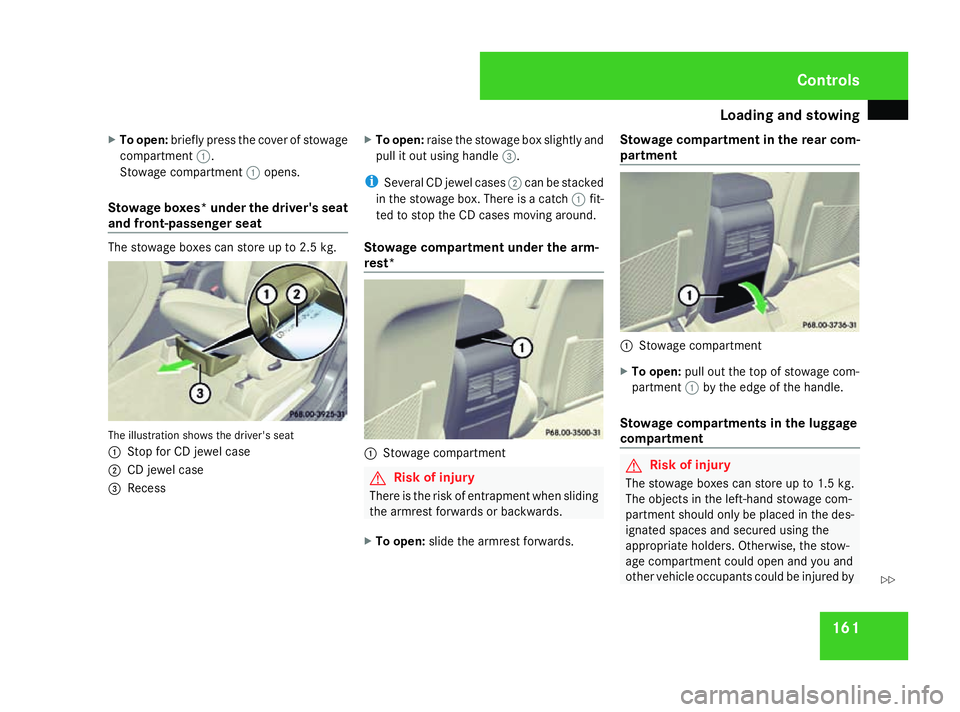
Loading and stowing
161
X
To open: briefly press the cover of stowage
compartment 1.
Stowage compartment 1opens.
Stowage boxes* under the driver's seat
and front-passenger seat The stowage boxes can store up to 2.5 kg.
The illustration shows the driver's seat
1
Stop for CD jewel case
2 CD jewel case
3 Recess X
To open: raise the stowage box slightly and
pull it out using handle 3.
i Several CD jewel cases 2can be stacked
in the stowage box. There is a catch 1fit-
ted to stop the CD cases moving around.
Stowage compartment under the arm-
rest* 1
Stowage compartment G
Risk of injury
There is the risk of entrapment when sliding
the armrest forwards or backwards.
X To open: slide the armrest forwards. Stowage compartment in the rear com-
partment
1
Stowage compartment
X To open: pull out the top of stowage com-
partment 1by the edge of the handle.
Stowage compartments in the luggage
compartment G
Risk of injury
The stowage boxes can store up to 1.5 kg.
The objects in the left-hand stowage com-
partment should only be placed in the des-
ignated spaces and secured using the
appropriate holders. Otherwise, the stow-
age compartment could open and you and
other vehicle occupants could be injured by Controls
169_AKB; 2; 4, en-GB
wdomann,
Version: 2.10.6 2008-07-16T08:52:06+02:00 - Seite 161 ZDateiname: 6515_0315_02_buchblock.pdf; preflight
Page 170 of 305
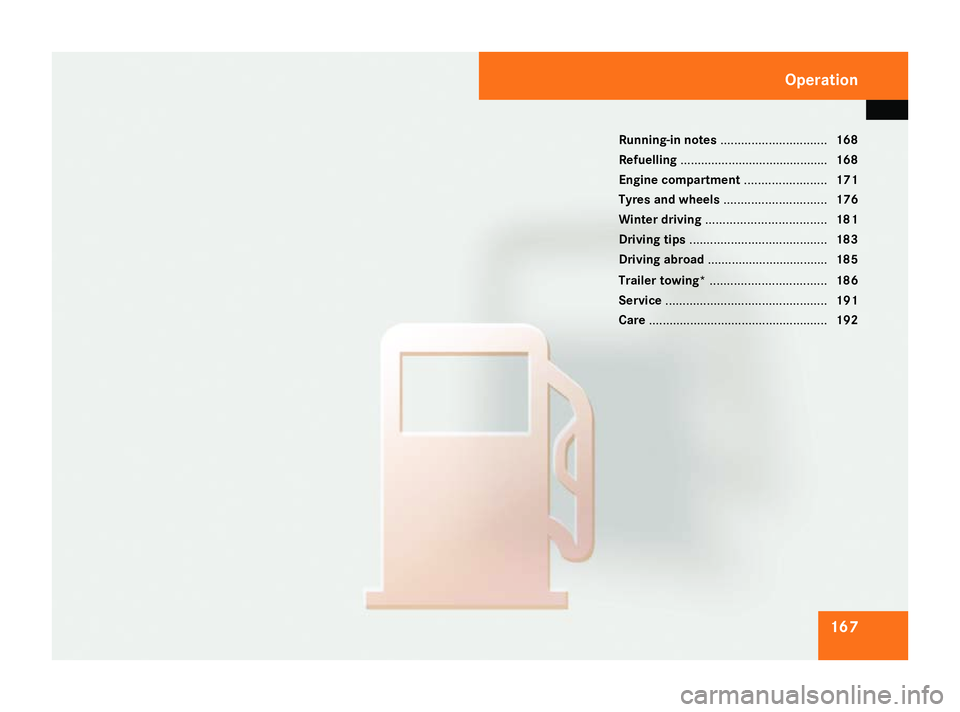
167
Running-in notes
............................... 168
Refuelling ........................................... 168
Engine compartment ........................171
Tyres and wheels .............................. 176
Winter driving ................................... 181
Driving tips ........................................ 183
Driving abroad ................................... 185
Trailer towing* .................................. 186
Service ............................................... 191
Care .................................................... 192 Operation
169_AKB; 2; 4, en-GB
wdomann,
Version: 2.10.6 2008-07-16T08:52:06+02:00 - Seite 167Dateiname: 6515_0315_02_buchblock.pdf; preflight
Page 183 of 305

Tyres and wheels
180 fully. Do not make any sudden steering
movements when doing so.
The function of the tyre pressure loss warning
system is limited or delayed if:
R snow chains are fitted to your vehicle's
tyres.
R road conditions are wintry.
R you are driving on sand or gravel.
R you adopt a very sporty driving style (cor-
nering at high speeds or driving with high
rates of acceleration).
R you are towing a very heavy or large trailer.
R you are driving with a heavy load (in the
vehicle or on the roof).
Restarting the tyre pressure loss warn-
ing system Restart the tyre pressure loss warning system
if you have:
R changed the tyre pressure
R changed the wheels or tyres
R fitted new wheels or tyres
X Before restarting, consult the table of tyre
pressures on the inside of the fuel filler flap
to ensure that the tyre pressure in all four tyres is set correctly for the operating con-
ditions concerned.
X Also observe the notes in the section on
tyre pressures ( Ypage 178). G
Risk of accident
The tyre pressure loss warning system can
only give reliable warnings if you have set
the correct tyre pressure.
If an incorrect tyre pressure is set, these
incorrect values will be monitored.
A tyre with insufficient pressure results in
vehicle instability when driving, thus
increasing the risk of an accident.
X Make sure that the key is in position
2(Y page 62) in the ignition lock.
You will see the following message on the
standard screen of the multi-function dis-
play (Y page 100)
X Press korj to select the tyre pres-
sure function:
Run Flat Indicator active
Menu: R-Button
X Press the reset button on the left of the
instrument cluster.
The following message appears in the
multi-function display: Restart Run Flat Indicat.? Yes Can-
cel
If you wish to confirm the restart:
X Press the æbutton.
The following message appears in the
multi-function display:
Run Flat Indicator restarted
After a teach-in period, the tyre pressure
loss warning system will monitor the set
tyre pressures of all four tyres.
If you wish to cancel the restart:
X Press the çbutton.
or
X Wait until the message
Restart Run Flat Indicator?
Yes Cancel disappears.
The tyre pressure values stored at the last
restart will continue to be monitored. Operation
169_AKB; 2; 4, en-GB
wdomann,
Version: 2.10.6
2008-07-16T08:52:06+02:00 - Seite 180 Dateiname: 6515_0315_02_buchblock.pdf; preflight
Page 186 of 305
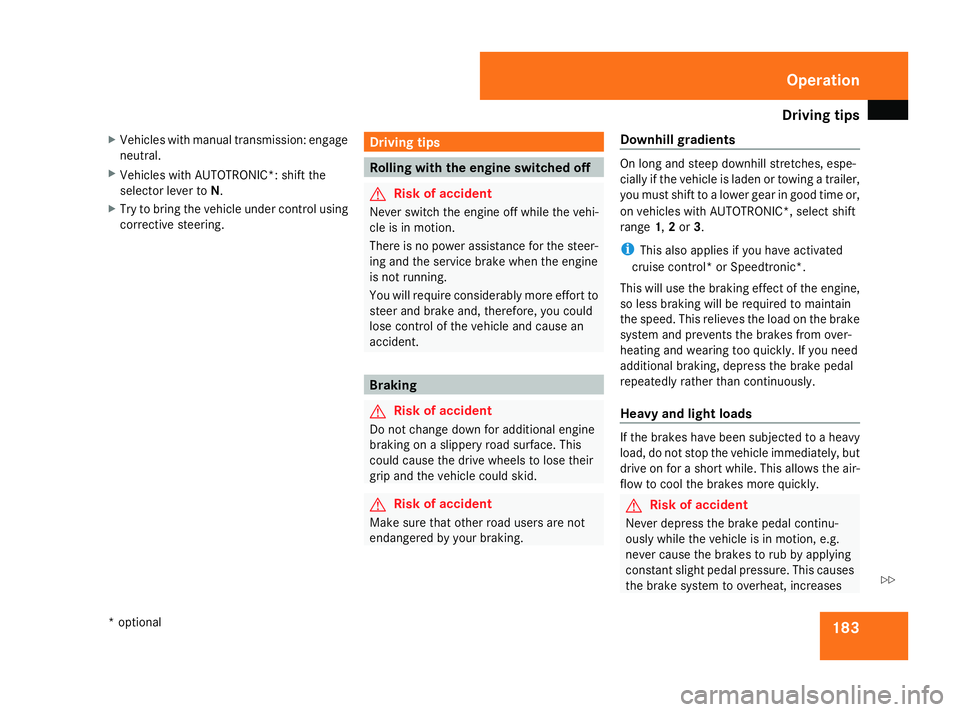
Driving
tips 183
X
Vehicles with manual transmission: engage
neutral.
X Vehicles with AUTOTRONIC*: shift the
selector lever to N.
X Try to bring the vehicle under control using
corrective steering. Driving tips
Rolling with the engine switched off
G
Risk of accident
Never switch the engine off while the vehi-
cle is in motion.
There is no power assistance for the steer-
ing and the service brake when the engine
is not running.
You will require considerably more effort to
steer and brake and, therefore, you could
lose control of the vehicle and cause an
accident. Braking
G
Risk of accident
Do not change down for additional engine
braking on a slippery road surface. This
could cause the drive wheels to lose their
grip and the vehicle could skid. G
Risk of accident
Make sure that other road users are not
endangered by your braking. Downhill gradients On long and steep downhill stretches, espe-
cially if the vehicle is laden or towing a trailer,
you must shift to a lower gear in good time or,
on vehicles with AUTOTRONIC*, select shift
range
1,2or 3.
i This also applies if you have activated
cruise control* or Speedtronic *.
This will use the braking effect of the engine,
so less braking will be required to maintain
the speed. This relieves the load on the brake
system and prevents the brakes from over-
heating and wearing too quickly. If you need
additional braking, depress the brake pedal
repeatedly rather than continuously.
Heavy and light loads If the brakes have been subjected to a heavy
load, do not stop the vehicle immediately, but
drive on for a short while. This allows the air-
flow to cool the brakes more quickly.
G
Risk of accident
Never depress the brake pedal continu-
ously while the vehicle is in motion, e.g.
never cause the brakes to rub by applying
constant slight pedal pressure. This causes
the brake system to overheat, increases Operation
* optional
169_AKB; 2; 4, en-GB
wdomann,
Version: 2.10.6 2008-07-16T08:52:06+02:00 - Seite 183 ZDateiname: 6515_0315_02_buchblock.pdf; preflight